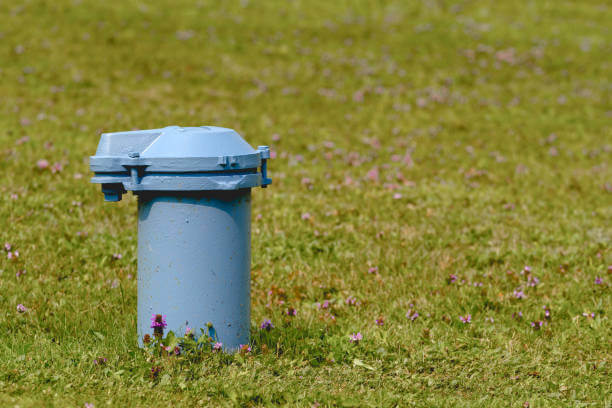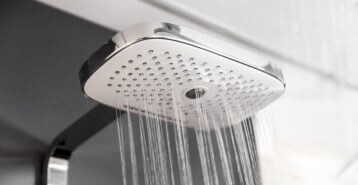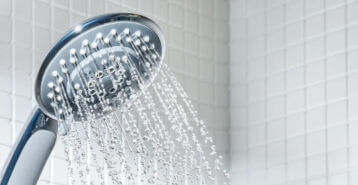Why Should You Treat Well Water?
Well water often contains naturally occurring minerals, microbes, and chemical contaminants. Some problems are easy to spot — like a rotten egg odor from sulfur, cloudy or discolored water from sediment, or reddish stains on laundry caused by iron or manganese buildup.
Other issues are invisible, such as bacteria, viruses, or arsenic. Hard water from calcium and magnesium shortens the life of your plumbing and appliances, while dissolved metals and volatile organic compounds (VOCs) can harm your health and home.
How Can You Tell If You Need a Well Water Treatment System?
Common signs include cloudy water, strange odors, or an unpleasant taste. Watch for these warning signs:
- A metallic or rotten egg odor
- Stains on clothing, sinks, showers, or toilets
- Cloudy, milky, or discolored water
- Grit or sediment in glasses or cookware
- Scale buildup in sinks or showers
- Soap that doesn’t lather well
- An off taste in water or food
Start with an at-home water test for bacteria, hardness, nitrates, or iron. A full lab test will show what contaminants you have and what treatment system is needed.
» Related: Signs You Need a Home Water Treatment System
What Are the Main Types of Well Water Treatment Systems?
There are several water treatment system types — including UV disinfection, sediment filters, and reverse osmosis — each addressing specific contaminants. Here’s a quick comparison.
Filtration Systems
Filtration systems remove particles, odors, and chemicals from water.
- Sediment Filters: Trap grit, silt, and sand — often used as the first filtration stage.
- Activated Carbon Filters: Remove chlorine, odors, bad tastes, and VOCs.
- Iron Filters: Convert dissolved iron or manganese into solids for easy removal, reducing stains and metallic taste.
Note: Filtration systems don’t remove bacteria or microbes.
Water Softeners
Water softeners use ion exchange to remove calcium and magnesium. Softer water prevents scale buildup, protects appliances, and improves bathing comfort.
Softeners don’t eliminate microbes or chemicals but can extend appliance life.
UV Disinfection Systems
UV systems use UV-C light to neutralize bacteria, viruses, and other microorganisms. They work best when paired with pre-filtration, as they don’t remove chemicals or minerals.
Reverse Osmosis Systems
Reverse osmosis (RO) filters water through a semi-permeable membrane, removing metals, nitrates, and salts. Because RO systems generate some wastewater, they’re typically installed under sinks or at a single tap. Whole-house RO systems are available for severe water issues but can be costly.
Whole-House vs. Point-of-Use Systems
Whole-house systems treat all the water entering your home — ideal for widespread hardness or microbial issues. Point-of-use systems treat water at specific faucets, like the kitchen sink. Many homeowners use both for best results.

Pros and Cons of Well Water Treatment Systems
Pros
- Cleaner, better-tasting water
- Reduced metals, chemicals, and microbes
- Protects plumbing and appliances
- Long-term savings — less bottled water and fewer repairs
- Can increase property value
Cons
- High upfront cost
- Ongoing maintenance required
- Some systems waste water
- Depend on consistent power
In many cases, installing a well water treatment system isn’t optional — it’s essential for safe, reliable water.
How Much Does a Well Water Treatment System Cost?
The average cost is about $2,300, with most homeowners spending between $1,000 and $5,000. Basic filtration starts near $200, while multi-stage systems can exceed $8,000.
| System Type | Typical Cost Range (Installed) |
|---|---|
| Basic sediment filter | $100 to $800 |
| Carbon filter | $250 to $1,500 |
| Water softener | $800 to $2,000 |
| Iron and manganese filter | $900 to $4,000 |
| UV disinfection light | $600 to $2,200 |
| Reverse osmosis (point of use) | $1,500 to $6,000 |
| Multi-stage system (whole house) | $2,500 to $10,000 or more |
Whole-house systems cost more but treat all your water; point-of-use systems are cheaper and focus on one location. Combining both can be most effective.
Maintenance Costs
Maintenance depends on system type. Expect recurring costs for filter replacements, resin refills, or UV bulbs. Typical upkeep costs:
| Maintenance or Replacement | Average Cost |
|---|---|
| Filter cartridge replacement | $30 to $200 |
| Softener salt and chemicals | $40 to $120 per year |
| UV lamp replacement | $100 to $150 per year |
| Professional servicing | $100 to $300 per visit |
Get connected with local water treatment pros today.
How to Choose the Right Well Water Treatment System
Selecting the right system depends on your water quality, household needs, and budget. Follow these steps:
- Get a water test: Measure pH, bacteria, hardness, iron, nitrates, heavy metals, and VOCs.
- Match the treatment: Use your test results — e.g., high iron needs an iron filter, hardness needs a softener, bacteria require UV or chlorination.
- Check your demand: Choose a system that meets your peak gallons-per-minute (GPM) needs.
- Compare costs and warranties: Get multiple quotes and compare support options.
- Plan for space and access: Ensure you have power, drain lines, and maintenance access.
Installation and Maintenance Tips
Professional installation ensures your system meets plumbing codes and maintains its warranty. DIY installation works for simple systems like sediment filters but can risk leaks or void warranties if done incorrectly.
Simple homeowner maintenance tasks include:
- Changing filters or carbon cartridges as recommended
- Replacing the UV bulb yearly
- Refilling the softener tank
- Checking pressure and flow regularly
Call a professional to service UV lights or recharge a softener’s resin bed. Schedule routine inspections to prevent issues early.
» Related: Best Water Treatment Companies of 2025
Compare top-rated water treatment pros in your area.
Read real homeowner reviews, explore qualifications, and view promotions. Modernize makes it easy to browse professionals and find one that will be perfect for your project.





